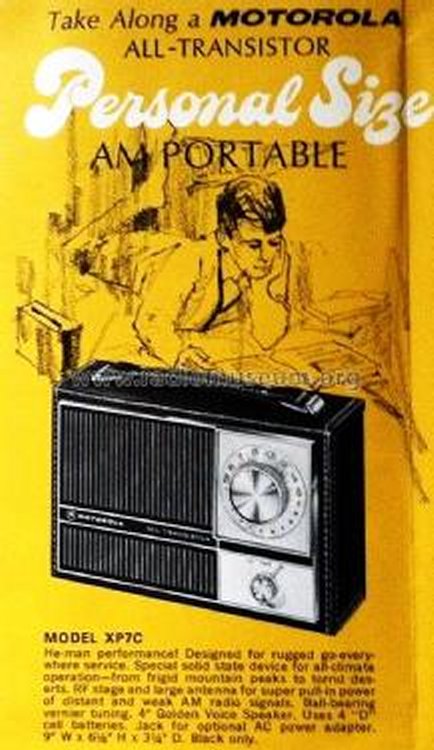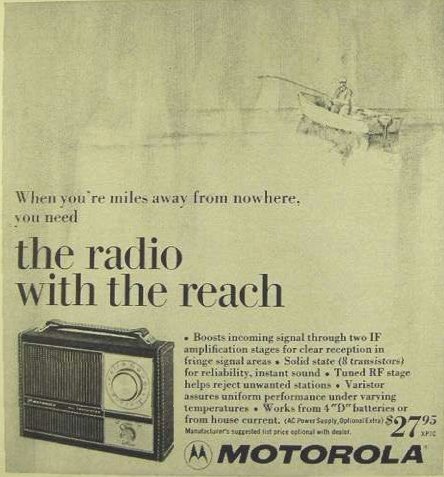Motorola XP7C/XP7CE AM Portable Radio
For those of you who follow my website you know that for the past few years I have been discovering more and more vintage analog portable radios. Many of these have been recommended to me by readers who wanted me to test these radios because they felt they are sleepers…radios with great performance that are not well known. I have discovered many new models that were indeed very nice although very few have challenged the long-accepted standard bearers like the Panasonic RF-2200, GE Superadio or SRII, the current-day C. Crane CC-2E/CC-3 or CC EP-Pro and a very few others. There’s a reason these radios are so well-known and universally regarded as references by radio people…they have stood the test of time. This Motorola was recommended to me by a reader who sent me one at a very low price because it is cosmetically challenged but he felt it was the hottest radio he ever had and that it had outperformed some those reference radios which I have rated as ***** which is quite a claim. I must admit I had never heard of this model before and I found very little information about it online but as usual I was extremely curious to see what it was all about.

Above: The XP7C Is A Nice Looking Radio
I discovered that it was sold as the XP7C and XP7CE, but after obtaining service manuals for both models it appears that they have the same chassis, HS-66206. My XP7C manual is the original Motorola manual downloaded from radiomuseum.org
the XP7CE manual is from SAMS
It is possible the different model designation refers to some changes other than the chassis… something to do with the cabinet for instance, or there might be some change not reflected in the SAMS but I have no way of knowing. The biggest difference between the two manuals is in the alignment procedure which I have seen many times before…having both in front of you helps with some nuances of tweaking the alignment but I won’t go into that here.
General Design & Discussion: The Motorola XP7C/XP7CE (which for simplicity I will refer to simply as the XP7C) was introduced in 1966 and sold for $27.95. It is an all-analog, lunchbox-sized 8 transistor design with a tuned RF stage, 3 gang air-variable vernier tuning condenser and a large 8 1/4” ferrite rod. There are a DC input jack and an earphone/speaker output jack. It’s an attractive radio and has a nice tuning feel and an easy to read dial scale. That’s great but as they say…wait…there’s more. The Motorola has 2 stages of IF amplification with 5 tuned stages which is highly desirable. The RF and IF circuits have exceptionally high gain with a low noise floor…it is this combination of high gain and low noise that makes this radio an exceptional performer.

Interior View Shows Very Large Ferrite Rod
AM sensitivity is often discussed but almost as often misunderstood. Raw sensitivity is the ability to hear very weak signals, but when there is little or no RFI (radio frequency interference) the radio’s internally generated noise (hiss) becomes a limiting factor. As signals get weaker this hiss becomes more bothersome which is why strong local stations have quiet backgrounds while weaker signals have hissy backgrounds. A radio with a better internal signal-to-noise ratio will render those stations with less hiss so they will sound stronger and clearer.
The Tuned RF Stage amplifies only the desired signal and helps increase dynamic range…the ability to receive weak signals in the presence of stronger signals.The IF design is responsible not only for gain but also selectivity and reduction of blocking or desensitization where weak signals are lost when stronger signals overwhelm the circuit. (I once compared two radios by the same manufacturer which had the same sensitivity on many weak signals but when there were stronger signals nearby the radio with the simplified IF design couldn’t hear the weaker signals even though there was no apparent interference from the neighboring signals). The XP7C should be outstanding in this regard.

Checking It Out: As I said the radio I got was cosmetically poor. The handle was taped together, the hinge at the bottom of the rear cover was taped and the original battery box was replaced by an incorrect one. The set was originally designed to run on 4 D cells but because of its extremely low current drain I temporarily installed a holder for 4 AA cells which should power the set for a long time…if battery life becomes a concern, I can always upgrade it to C or D cells in the future. After obtaining the service information I verified that the alignment was extremely close which is always reassuring but I went through the procedure very carefully and got incremental improvements here and there including improved dial accuracy.

Above: Clutch Head Screw Can Be Removed With Standard Slotted Screwdriver
Access for service was fairly easy with few complaints. In an unusual design the ferrite rod is released by removing two screws on the left and right sides of the radio. After pulling off the front panel knobs remove one screw beneath the tuning dial and 6 securing the circuit board which can now be lifted out. I’ve never seen this style of screw head before but have been advised it is called a clutch head and that it will stay on the driver so you can reach into tight places to start it…the right sized straight screwdriver engaged them perfectly. Since the ferrite rod is now dangling by its wires use caution to avoid breaking them…they can easily be unsoldered but then you can’t align the radio. It was not necessary to desolder the wires leading to the speaker, DC input or earphone jack as there is enough wire to allow fairly easy board access. The radio contains 5 electrolytic caps but all tested strong and the radio seemed quite powerful.
Because the person who sent it to me claimed it was the hottest AM radio he had ever seen and that it beat at least one of my ***** rated AM radios I immediately put it head-to-head with that radio and several others before I did anything inside the radio. Comparisons were carried out in low noise and medium noise locations and included the reference radios I mentioned earlier which are all ***** radios and a Zenith Royal 755M which is rated **** 1/2. (I repeated all of these tests after I aligned the radio but the “as found” alignment was so close that little difference was observed other than better dial calibration).

The results were interesting and the one thing I noted was that the XP7C has exceptional audio gain (sometimes referred to as reserve volume) such that some weak signals play more loudly than on other radios. But as I always find, after tabulating the comparison results on many frequencies there were one or two that were quieter on the Motorola than the others in the tests and all of the radios mentioned were able to play loudly even on most very weak signals. In terms of signal to noise ratio on medium to weak signals the Motorola XP7C ranks an extremely respectable **** ½ in the AM Mega Shootout list which places it very near the best.
The Verdict: The Motorola XP7C is indeed a sleeper. There is almost zero information about it on the internet, there are few available on eBay (I haven’t seen any after several weeks of searching) and I have never seen it referred to before on any forum. It does get beat out by the ***** reference radios but not by much…it ranks **** 1/2. Considering how good it is I’m surprised I had never heard of it before. It impresses with its strong performance and is a radio I’m glad to have gotten to know.
You must be logged in to post a comment.